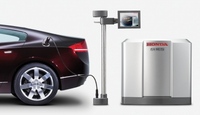Author Charges: Honda is Deliberately Sabotaging it's Own Hydrogen Fuel Cell Efforts
Honda Hydrogen Hoax: Japanese Carmaker Says Hydrogen Car Must Await Filling Stations While Suppressing Home Refueling Device
 |
Japanese Honda is delaying for years a national rollout of its dynamic new Clarity hydrogen car, and manufacturing just a handful of test cars, mainly for the Los Angeles area, because the company claims cities lack hydrogen filling stations. But the claim is an apparent hoax. Honda’s Clarity was designed for home refueling and was developed with a companion Home Energy Station, now undeployed and forgotten.
Unquestionably, Honda again achieved the alternative energy limelight with the rollout of its sleek and stylish hydrogen fuel cell vehicle, the Clarity. Boasting kinetic body styling, an exquisite interior, par excellence handling and roadability, the Clarity is a feat of automotive engineering. Most remarkably, the car uses no petroleum. Instead, its fuel cell uses hydrogen reformed from natural gas or electrolyzed from water. Hydrogen can also be made through a bacterial reaction, and several laboratories are trying to improve the yields.
EDITOR'S NOTE: Edwin Black will be speaking at the Western Automotive Journalists' Future Fuels and Propulsion Systems program on Wednesday, October 15th in South San Francisco. If you're a member of the media or the automotive industry and would like to attend please visit the WAJ website at www.waj.org for more information.
In 2005, Honda insisted its advanced hydrogen car would not be ready for the first consumers until 2012. As rapid progress was made on the vehicle’s technology and design, the release date was steadily advanced until Honda premiered its dazzling Clarity at the 2007 Los Angeles Auto Show, promising a summer 2008 availability. The vehicle was rolled out as promised. But to the disappointment of many, only a few Clarity vehicles were actually produced. These were leased to specially selected personalities in the Los Angeles area. Honda has stated it only plans to produce a few hundred more between 2007 and 2010. “Basically, we can mass produce these now,” admitted Kazuaki Umezu, in charge of Honda’s Automobile New Model Center in Japan, where the FCX Clarity is built. “We are waiting for the infrastructure to catch up.”
Honda’s “no infrastructure” excuse is false, an investigation reveals. Like the Civic GX, the Honda Clarity was designed as a home-fueled vehicle. Now that Honda has sidelined the home hydrogen refueling appliance, the company claims hydrogen gas stations cannot be found
For years before the rollout, Honda’s hydrogen car, then known as the FCX, was pictured in advance promotions as a vehicle connected to a box, a little larger than a backyard air conditioner. That box is Honda’s Home Energy Center, designed to “reform” ordinary household natural gas, providing the electricity needed to run an entire home as well as fuel at least one hydrogen vehicle. Like the CNG car, the hydrogen vehicle was designed to require no public infrastructure.
Where is the Home Energy Center? The device has been developed by Plug Power of Latham, New York, which specializes in advanced hydrogen technology. But Plug Power’s device is controlled through a strict licensing agreement with Honda. A Plug Power manager at the National Hydrogen Association’s 2005 convention in Washington D.C. stated that the Home Energy Center could be made somewhat more compact but was good enough to go into mass production within months of receiving the go-ahead. He stated that the only thing holding the product back was Honda, which controlled the license.
By 2007, it was clear that Honda was consciously going slow on the development, deployment and sale of the Home Energy Center. In promotions, the company began omitting references to the essential home fueling component of its sleek new hydrogen car. Instead, the company emphasized the new need for metropolitan filling stations—a fueling infrastructure— which it rightfully claimed was years in the making. But this was the exact opposite of what they had committed to when they developed the car and its companion Home Energy Center.
When asked, Honda officials began cryptically claiming the product was “not ready.” Yet efficient hydrogen devices are readily available in Tokyo and stacked outside Tokyo households to generate residential electricity. By deliberately going slow on the Home Energy Center—the very device designed to create individual freedom from infrastructure—the highly-regarded Japanese carmaker has essentially laid out a decade-long phase-in for the vehicle and ensured that more than 99 percent of the United States will have no access to its hydrogen vehicles for years to come.
In early 2008, a senior Plug Power manager with day-to-day involvement with the Honda refueling device told this reporter, “It works well. It’s running well. But it is Honda’s call.” In late summer 2008, a Plug Power staffer involved with the project, repeated the assertion. “It works fine the way it is,” he stated, “What year it comes out is Honda’s call. Please call Honda.”
When asked, yet another Plug Power official stated, “If Honda accelerates the program, we will accelerate it. If they don’t, we can’t.”
Certainly, any home refueling center will be improved over time, like cell phones, computers, televisions and automotive technology. But the mass deployment of the Home Energy Station seems to have simply been withheld.
Why would Honda hold back on its own marvelous technology? Japanese Honda has understood that if it mass produces the Clarity and Home Energy Station, the public will flock to it as fast as they have been fleeing from Honda SUVs and similar gas guzzlers. While Honda makes some of the most fuel-efficient and well-engineered cars in America, the Japanese company also makes gas guzzlers, such as the Honda Ridgeline crossover pick-up which only achieves about 15 MPG in the city, the snazzy S-2000 sports car at 18 MPG, and the Pilot midsize SUV at about 16 MPG. In July, 2008, sales of the Pilot, manufactured in Alabama, posted a 47 percent drop over the previous year, just 7,486 compared to 13,136 in July, 2007. Pilots were down more than 21 percent for 2008. Sales of other Honda gas guzzlers plummeted as the market for such vehicles by all makers completely collapsed in mid-July, 2008. When the market for SUVs collapsed, SUV leasing programs by numerous auto companies nearly all terminated during a several-day period in July, 2008.
Helping America and the world out of its financially wracking oil addiction would hamstring overall profits for the Japanese carmakers. In the case of the Honda Civic GX and Clarity, the company may have indeed gone slowly on its best alternative fuel vehicles, keeping them out of America’s anxious hands, for no reason other than the preservation of profits on gas guzzling vehicles well into the third decade of the 21st century. Honda cars, generally among the best built in the world, boast a scrappage rate that can easily exceed a decade. Vehicles sold in 2009 and 2010 can be expected to require parts and service for at least a decade.
A parallel dynamic is the knowledge that as the nation flees the gas guzzlers of GM, Ford and Chrysler, they will flock to the more fuel efficient Honda models, such as the Civic, the Accord and the Fit. Hence, Honda can dominate the fuel efficient category while keeping its customers on oil.
Although Honda is holding back its hydrogen car using the well-worn “infrastructure” canard, hydrogen vehicles operating with either internal combustion engines or fuel cells have been created by GM, Ford, BMW, and other manufacturers. Each of the majors has developed its version of this cleanest car. GM hopes to mass produce hydrogen cars for the Chinese market as soon as possible. But hydrogen is scheduled to be kept from American purchasers for years to come.
About the Author
Edwin Black, who has always driven Honda cars, is the New York Times
best selling investigative author of IBM and the Holocaust, Internal
Combustion and his just released book, The Plan: How to Save America When
the Oil Stops—or the Day Before (Dialog Press), from which this
article is adapted. More information about The Plan can be found at www.planforoilcrisis.com.



